1. Background
According to the World Bank, Cambodia’s agricultural gross production grew by 8.7% during 2004-2012 mainly due to higher productivity of paddy rice. There was also a significant increase in maize (20%), cassava (51%), sugarcane (22%), and vegetables (10%) production. Agricultural exports – including rice, cassava, maize, pepper, fresh mango, and raw palm oil – reached 4.2 million tons in 2018, accounting for 22% of Cambodia’s GDP and employing about 3 million people.
Kampong Thom province covers an area of 1 506 100 ha, of which 278 228 ha (18.5 %) is rice paddy and 76 738 ha (5%) is fruit and permanent crop areas. Major crops include maize, cashew, cassava, rubber, bean, sesame and sugarcane.
Like many countries in the world, Cambodia’s forests are under mounting pressures. Trees are being cut down and replaced with cash crops like cashew nuts, and cassava. Many trees disappear due to the need for large and small-scale economic development. On small scale deforestation, in the last decade, forested areas have been rapidly cleared for small scale agricultural lands, with deforestation generally accomplished by hand through an unplanned process. These small-scale farming practices represent a primary underlying cause of deforestation in Tumring REDD+ Project area.
Since 2015, the Tumring REDD+ Project has supported 14 community forest (CF) groups located in 17 villages in Kampong Thom to protect remaining forestland from illegal forest land encroachment. One of the project’s objectives is to support local communities’ livelihood by increasing agricultural productivity. To implement this objective, the Project Management Unit (PMU) provided agricultural supports to three different CFs (Kbal Doung Tey, O’Kranhak, and Prey Ta Tey), starting in early 2019. After selecting 75 active households from these CFs, PMU in partnership with Kampong Thom’s Agricultural Department started to provide a range of supports, including rice drum-seeders, a climate resistant rice variety, new breed of cassava and organic fertilizers and compost houses.
Agricultural support impact assessment plays an important role in ensuring effectiveness of supports into this project area. Thus, this information brief assesses the effectiveness of supports provided to the three targeted CFs. Based on findings from this assessment, this information brief offers recommendations on how to improve agricultural productivity for other CF members to improve livelihoods of other CF members within and near the project area. This should then lead to slowing down of deforestation rate not only in the project area, but also in the whole province.

A community member was trained by an agricultural staff contracted with the Tumring REDD+ project.
2. Data Collection Approach
Methods used to collect data for this study were questionnaires, semi-structured interviews, in-depth interviews and field observations. Interviews were conducted with CF members to assess their farmed crops and farmland areas. 75 CF members (15 of whom were women) representing 75 household members in the three CFs participated in the questionnaires and interviews. Interviewer was a staff of Sandan’s Agricultural Office, which is a partner of the Tumring REDD+ project. Interviewees were either husband or wife, who are CF household members. Field observations were also conducted at the project site to gather information on the status of available crops, farmland areas and its storage facility. Additional to these primary data, the research team also gathered secondary data from different sources of literature such as reports and news articles to contextualize and validate findings from the questionnaires, field observations and interviews. Data analysis was done using Microsoft Excel 2016.
3. Key Findings
3.1 Participants
A proportion of the respondents (55%) were in the 40-50 age group. A majority of the participants did not have any educational background, while only 6% (20-30 age group) went to school, studying between grade 1-5. Regarding agricultural experience, a majority of the interviewees (70%) have been farming for 10 to 15 years. Almost all CF members (95%) have been planting rice, cassava, cashew and raising cattle and poultry for decades – farming and grazing on their agricultural land size that ranged from 1.5 to 10 ha.
3.2 Agricultural Productivity in 2018
Rice and cassava were the main agricultural crops in 2018. Regarding agricultural land for rice, O’ Kranhak and Prey Tatey CFs have smaller farmland compared to Kbal Dountey CF, accounting for around 0.5-2 ha and 2-4 ha, respectively. Conversely, Prey Tatey and O’ Kranhak CFs’ agricultural yields were at 2 000 – 2 500 kg per ha, while Kbal Dountey’s rice production was a bit lower at 900 – 1 300 kg per ha. In terms of cassava, the yields for all three CFs were similar. CF members from the three CFs have occupied farmland for cassava plantation from around 1 to 4 ha, and this land could produce about 5 to 12 ton of cassava per ha.

Community members received organic fertilizers for their farming activities.
3.3 Agricultural Productivity in 2019
Tumring REDD+ Project provided a new climate resilient rice variety, compost houses and drum-seeders to the three CFs mentioned in section 3.2. Prey Tatey CF produced the highest rice production. It produced about 2 000 to 3 500 kg of rice per ha. This was the result of the families using drum-seeder and compost houses. However, O’ Kranhak CF generated the lowest yields at 1 000 to 2 000kg of rice per ha using the same drum-seeder and compost houses. Amount of compost used and deteriorated soil fertility were the reasons behind this low productivity. Kbal Dountey CF showed a moderate level of cassava production, producing about 2 000 to 3 000 kg of cassava per ha. Note that in Kbal Dountey CF only used drum-seeder and compost house during plantation stage.
An insect and climate resilient cassava seeds supported by the Tumring REDD+ project was distributed to 75 different householders within the three CFs. High productivity was observed in Kbal Dountey and Prey Tatey CFs which produced about 10 to 20 tons of cassava per ha. 20 households in Kbal Dountey and 25 households in Prey Tatey CFs applied organic fertilizers. However, 25 households in O’Kranhak who used organic fertilizers generated the lowest cassava yield per ha, between 5 and 15 tons.

Community members sold their cassava to a middleman in the village.
3.4 Reducing Forestlands Clearing
Comparing the agricultural productivity in 2018 and 2019, rice and cassava productions in 2019 were higher than that of 2018. For example, in 2018, CFs were only able to produce about 900 to 2 500 kg of rice per ha as compared to about 1 000 to 3 500 kg per ha in 2019 (see table 1). In terms of cassava, the productivity increased from between 5 and 12 tons per ha in 2018 to between 5 to 20 tons per ha in 2019.
With the increase in their agricultural productivity, CF members tend to reduce forestland-clearing approach. A vast majority of the respondents (95%) answered that they would not clear more forestlands for agricultural lands – describing it as an illegal activity and showing their tendencies to farm on existed agricultural lands to produce their agricultural products.
To increase agricultural productivity, CF members requested a number of supports. A new cassava breeds, variety of rice seeds, compost houses and other organic fertilizers were the top requests. Additionally, CF members also considered farming other potential cash crops to attract other markets.

Community members harvested their rice.
Table 1: Yields of rice and cassava in 2018 and 2019
| Yields/ Year | 2018 (kg) | 2019 (kg) |
| Rice | 900 – 2 500 | 1 000 – 3 500 |
| Cassava | 5 000 – 12 000 | 5 000 – 20 000 |
3.5 Challenges
The interviews revealed that there are several challenges that household members faced. These include:
- While the new cassava breed produced higher yields, it is prone to diseases and thus require treatments.
- Climate change is posing threats on farmers as higher temperature, drought and more insects were seen more often in 2019 compared to previous years.
3.6 Opportunities
The interviews also revealed the following opportunities for potential investors, which could then help improve CF members’ livelihood:
- A new rice variety and a new cassava breed produced higher yields, and thus increases the income among community members.
- When earning more, community members tend to farm on their existed agricultural lands and thus reduces clearance of forestlands.

Cassava stocked at a middleman’s place in the village near the CF members’ houses.
4. Recommendations
Drawing from the key findings section, the following recommendations are proposed:
- Keep collaborating with Department of Agriculture, particularly in agronomy,
- Continue to support community members with more agricultural techniques to treat diseases and mitigate and adapt to climate change,
- Strengthen the link between existing Agricultural Cooperatives (ACs) and CF members,
- Encourage ACs to by agricultural yields from CFs and thus creating more markets,
- Scale up the support to other CFs in the area to increase the project’s impacts.
Acknowledgement
This information brief was supported by Tumring REDD+ Project and was prepared by the Project Management Unit (PMU). The PMU was assisted by Sandan Agricultural Office’s staff and management committee members of Kbal Doung Krey, O’Kranhak, and Prey Ta Tey CFs to conduct interviews with their CF members.


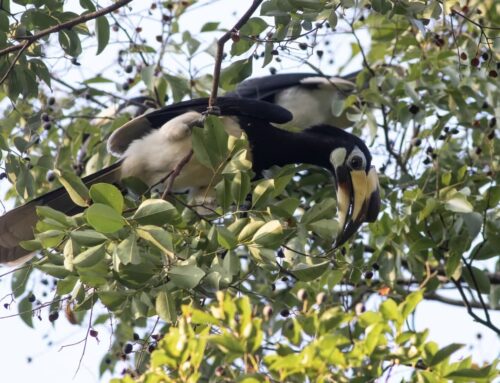
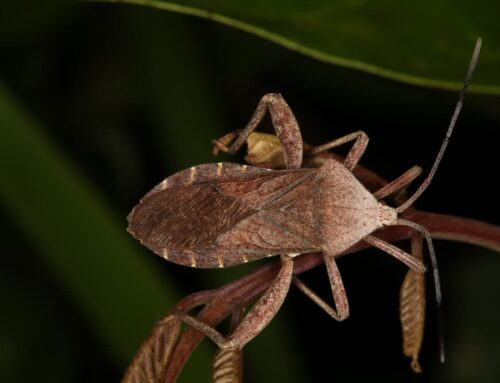
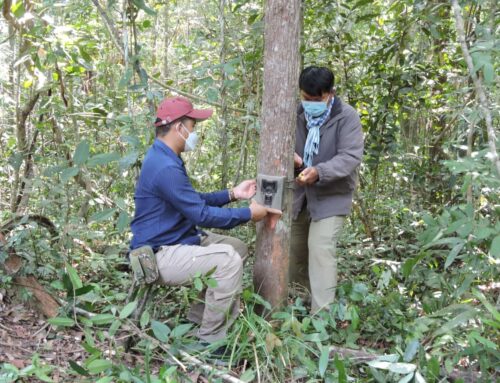
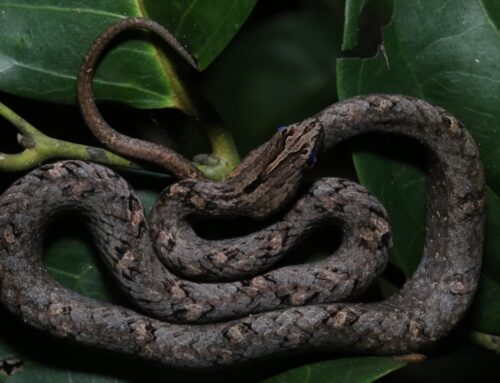
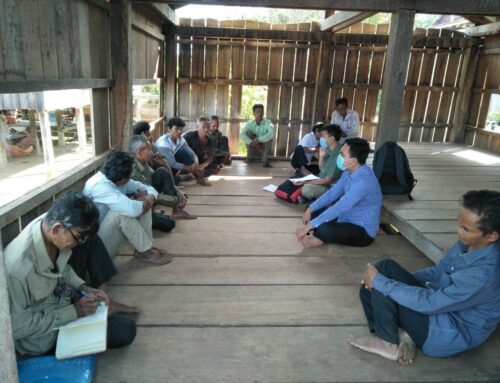
Leave A Comment